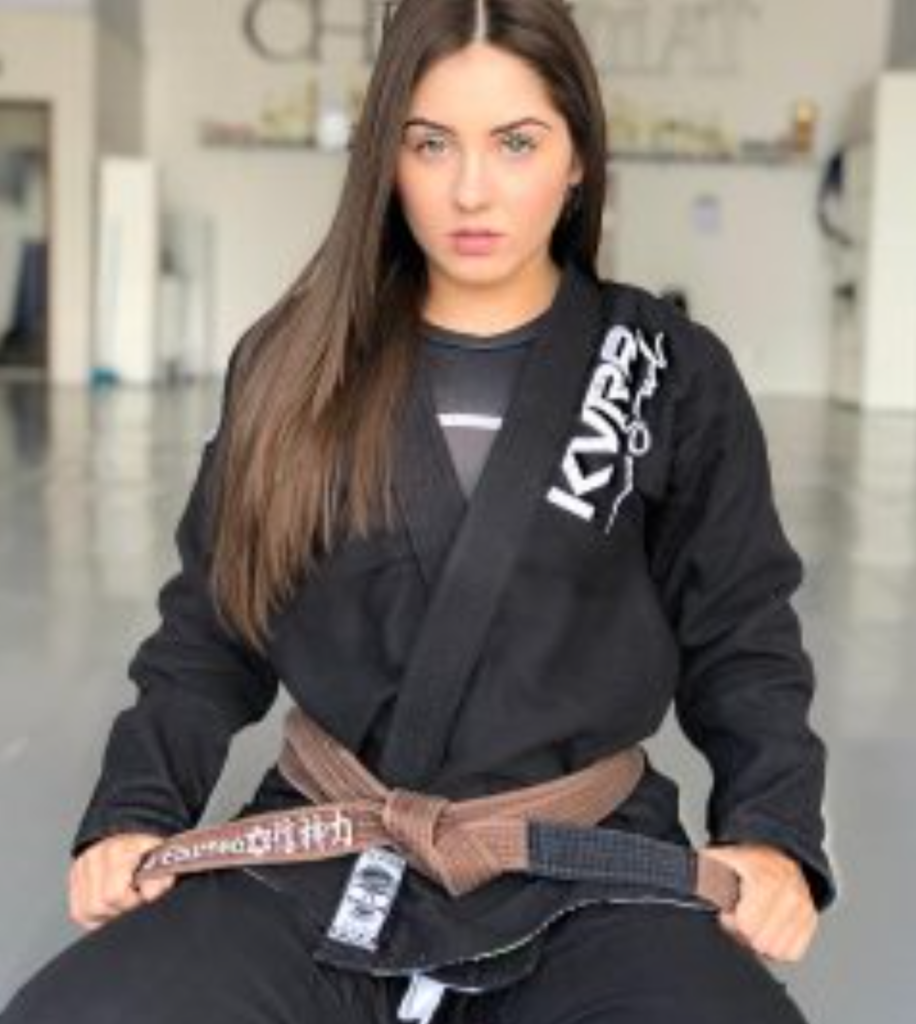
As a dedicated Jiu-Jitsu enthusiast, the aspiration of achieving a black belt rank likely resides in your mind. However, you must first face the demanding and fulfilling brown belt Jiu-Jitsu level, a pivotal point of your path, before reaching your destination.
The brown belt denotes the ultimate stage of proficiency, expertise, and commitment in the Brazilian Jiu-Jitsu hierarchical structure and is the last of the colored belts.
The belt known for its challenging nature in BJJ is widely acknowledged to be the one that readies practitioners for their ascent to the coveted black belt.
That said, what are some of the requirements, expectations, and responsibilities of this rank? How can you make the most of your time as a brown belt and enjoy the journey? And how can you prepare yourself for the final step to the black belt?
Understanding the Brown Belt in Jiu-Jitsu
Before we dive into the details of how to become a brown belt and what to do as one, let’s first define what this rank means and how it fits into the jiu-jitsu belt system.
What is the Brown Belt Jiu-Jitsu rank?
A brown belt in Jiu-Jitsu is the fourth level in the ranking system, representing a significant achievement. It is acquired after the white, blue, and purple belts and before the black belt in the hierarchy of belts.
A brown belt signifies that you have mastered the fundamentals of Jiu-Jitsu and have developed a solid and diverse game. You are able to execute techniques with precision, efficiency, and creativity, and able to adapt to different situations and opponents, imposing your game plan along the way.
The brown belt Jiu-Jitsu rank also implies that you have a deep understanding of the underlying concepts and principles of grappling. At this point, you are able to explain and teach techniques to lower belts and can analyze and improve your own performance. You also possess an understanding of both your strong suits and areas for improvement and have a well-defined idea of your objectives.
Being a brown belt also reflects that you have a strong commitment and passion for Jiu-Jitsu. You have trained consistently for several years, overcoming challenges, injuries, and plateaus.
How Does the Brown Belt Rank in the Jiu-Jitsu Belt System?
The brown belt is the last of the colored belts in the BJJ belt system, which consists of five main belts: white, blue, purple, brown, and black. Each belt has a different meaning and requirements, depending on the age and experience of the practitioner.
- White belt is the beginner level, where you learn the basics of jiu-jitsu and develop a foundation for your game.
- Blue belt is the intermediate level, where you expand your repertoire of techniques and start to develop your own style.
- Purple belt represents the advanced level, where you refine your skills and deepen your understanding of jiu-jitsu.
- Brown belt is the expert level, where you polish your game and prepare yourself for the black belt.
- Black belt means you’ve achieved the master’s level, where you demonstrate a high degree of proficiency and knowledge in Jiu-Jitsu.
The black belt also has different degrees, from 1st to 9th, which indicate the seniority and recognition of the practitioner.
The jiu-jitsu belt hierarchy also includes exclusive belts like the coral belt (red-and-white) and grandmaster belt (red) that are awarded to highly respected black belts for their exceptional dedication and valuable contributions to Brazilian Jiu-Jitsu.
The Journey to the Brown Belt Jiu-Jitsu Rank
Now that we have a clear understanding of what a brown belt is and how it ranks in the jiu-jitsu belt system, let’s explore how one can achieve this rank and what it entails.
How Long Does It Take to Get a Brown Belt in Jiu-Jitsu?
While there is no definitive answer to this question, there is a selection of different factors that can influence the time it takes to get a BJJ brown belt. Some of these factors include:
- The frequency and intensity of your training.
- The quality and quantity of your instruction.
- The level and diversity of your training partners.
- Whether or not you’re competing and the difficulty of the tournaments.
- The personal and professional obligations you have outside of Jiu-Jitsu.
- The physical and mental challenges you face along the way.
- The individual criteria and expectations of your instructor.
However, based on some general estimates and averages, one can expect to spend at least 6-8 years of consistent training to reach the brown belt level. This means training at least 3 times a week for about 2 hours per session.
Of course, this is just a rough approximation, as some people may take longer or shorter than that, depending on their circumstances and abilities. Some exceptional cases may even achieve the brown belt in less than 5 years, such as Gordon Ryan, who got his brown belt in 4 years and 8 months.
Challenges and Obstacles Brown Belts Face
The journey to the brown belt Jiu-Jitsu rank is not a smooth or easy one. You will likely encounter some difficulties and setbacks along the way, which may test your resolve and commitment. Some of these challenges and obstacles may include:
- Injuries: Jiu-Jitsu is a physical sport that involves a lot of contact, pressure, and movement. As such, it carries a risk of injury, especially if you train hard or compete frequently
- Plateaus: Grappling requires constant adaptation and improvement. At certain intervals, you’re likely to encounter periods of stagnation, during which you perceive yourself as not making any advancement or acquiring fresh knowledge.
- Frustration: Jiu-jitsu is a competitive and challenging martial art that exposes your weaknesses and mistakes. It is understandable and expected to feel frustrated, especially if you face opponents who are better or stronger than you, or if you fail to achieve your goals or expectations.
- Boredom: BJJ is rarely seen as a repetitive activity, but do anything for longer than 5 years and you’ll find something to be bored with, whether it is drills or warm-ups.
- Pressure: Jiu-jitsu is a demanding and rewarding sport that requires a lot of dedication and passion. Pressure is something you place on yourself, especially if you have high standards and expectations of yourself.
How Can You Overcome These Challenges and Obstacles?
Some resources and strategies that can help you overcome these challenges and obstacles, and make the most of your time as a brown belt include:
- Recovery: BJJ is a taxing activity that demands a lot of your body and mind. Ensuring your health and wellness demands a focus on essentials such as adequate rest, proper nourishment, hydration, regular stretching, and similar self-care measures.
- Variety: Spicing up your training and keeping it fun and interesting is always a good idea. Trying out new techniques, attending different classes, visiting other gyms, training with different partners, competing in different events, and cross-training in other grappling martial arts are grat ways to break your routine.
- Feedback: Jiu-Jitsu is a collaborative environment involving much communication and interaction. Seek and receive feedback and guidance as much as possible. Ask questions, listen to advice, watch videos, read books, and learn from anyone who can help you improve.
- Mindset: Try to cultivate a positive and constructive mindset, by setting realistic and achievable goals, celebrating your achievements, embracing your challenges, and enjoying the process.
Skills and Mindset of a Brown Belt
Now that we have explored how to get to the brown belt Jiu-Jitsu rank and what to do as one, let’s examine what skills and mindset you should have as a brown belt, and how to develop them.
Physical Skills of a Brown Belt
A brown belt Jiu-Jitsu practitioner should have a high level of physical skills, which include:
- Technical knowledge: A brown belt should be able to execute techniques with precision, efficiency, and creativity. They should have a solid foundation of fundamentals, but also be able to adapt and improvise according to the situation. At this stage, having a broad range of jiu-jitsu skills including takedowns, guard passing, sweeps, submissions, escapes, transitions, and more, is a highly justifiable expectation.
- Timing: As a brown belt you should be able to apply techniques with the right timing and precision. That means knowing when to initiate, maintain, or abandon a technique.
- Control: Controlling the opponent with pressure, leverage, and positioning are all brown belt Jiu-Jitsu traits. Control, however, extends beyond just pinning the other person. Brown belts need to be able to control themselves with balance, posture, and breathing. They should also be able to set the pace and direction of a match or roll and impose their game plan.
Mental Skills of a Brown Belt
A person holding a brown belt in Jiu-Jitsu should possess specific mental abilities, including a profound comprehension of the fundamental concepts and principles of Brazilian Jiu-Jitsu. They should be able to explain and teach the biomechanics of different grappling techniques to lower belts and to analyze and improve their own performance.
- Confidence: Grapplers who have reached a brown belt are expected to believe in themselves and their game plan, and trust their instincts and decisions.
- Humility: Humility in attitude and behavior is an important characteristic of brown belts. They have to respect themselves and others, regardless of rank or skill level, be humble enough to admit their mistakes and limitations and to seek feedback and guidance from others.
- Resilience: Coping with stress, pressure, injuries, and the like is normal when you’re an expert in grappling. Expect to overcome lots of challenges and setbacks as a BJJ brown belt.
The Meaning and Significance of the Brown Belt Jiu-Jitsu Rank
Having achieved the brown belt rank in Jiu-Jitsu, you possess not only a particular set of abilities and perspectives, but also a degree of acknowledgment and deference. The brown belt has a meaning and significance that goes beyond the technical and tactical aspects of BJJ, and that reflects your personal growth and character development.
What Does the Brown Belt Symbolize?
The brown belt symbolizes different things in Jiu-Jitsu, depending on the perspective and interpretation of the practitioner. However, some common themes that emerge are:
- Maturity: You have a clear sense of who you are and what you want in grappling. You have developed a mature attitude towards your training, your goals, your challenges, and your achievements.
- Excellence: Achieveing a high standard of performance and quality in your Jiu-Jitsu game, as well as in your attitude and behavior, showing professionalism, integrity, and ethics.
- Dedication: Dedication to your team and your instructor, and all the time and effort put into achieving the brown belt Jiu-Jitsu rank does not go unnoticed.
- Passion: The brown belt symbolizes passion, which means you have a strong love and enthusiasm for Jiu-Jitsu, which you also share with others, inspiring them and teaching them.
These themes are not exclusive to the brown belt level, as lower belts may also embody some of them to a certain degree. However, a brown belt should have fully embraced these characteristics and should be able to express them consistently and confidently.
What Is the Responsibility and Role of a Brown Belt in Jiu-Jitsu?
Having the rank of brown belt comes with a responsibility and role that goes beyond the technical and tactical aspects of jiu-jitsu, and that reflects your contribution and influence in the Jiu-Jitsu community.
As a brown belt, you have a responsibility and role to:
- Be a role model: As a brown belt, you are a role model for lower belts, who look up to you and admire you. You should set an example of excellence and professionalism in your training and your behavior.
- Be a mentor: Apart from being a role model you’ll directly mentor lower belts, who seek your guidance and advice. Make sure to help them learn and improve their Jiu-Jitsu skills and mindset. and encourage them to overcome their challenges and achieve their goals.
- Be a leader: A leader for your team, for your students, the right hand of your black belt instructors, always ready to jump in.
- Stay a student: Remember that even though you are a brown belt Jiu-Jitsu pracitioner, you are still a student who has more to learn and improve. Keep an open mind and a curious attitude toward new techniques and concepts.
Preparing for the Black Belt
The black belt represents a high degree of mastery and knowledge in BJJ, as well as a lifetime commitment and passion for the art.
However, the black belt is not just a matter of time or rank. It is also a matter of skill and mindset. The distinction between a brown belt and a black belt extends beyond their belt color and can be felt quite strongly.
As a brown belt, you should prepare yourself for the black belt by bridging the gap between the two belts.
Aim to refine your strengths, address your weaknesses, expand your repertoire, and develop your own style. Keep training hard, competing regularly, learning constantly, and sharing generously.
Conclusion
The brown belt level is a highly demanding and fulfilling phase of your Jiu-Jitsu expedition. It is a stage where you have mastered the fundamentals of Jiu-Jitsu, and have developed a solid and diverse game. It is also a stage where you have a deep understanding of the concepts and principles of jiu-jitsu, and have developed a confident and humble mindset.
Watch BJJ Brown Belt Ashton Kutcher Sparring With Craig Jones
2 Worst Belts For BJJ Imposter Syndrome (And Dealing With It)
The Threat Is Real: Megadeath’s Dave Mustaine Gets Brown Belt


















































